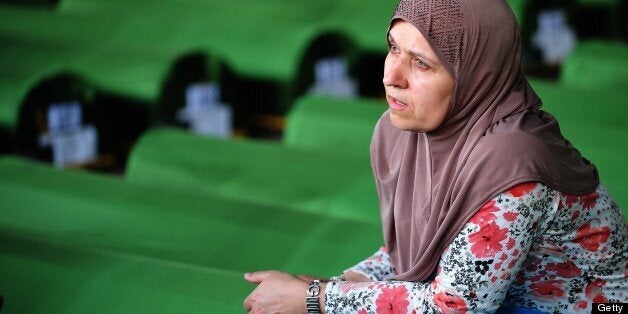
Who are the survivors of the Srebrenica genocide? After losing multiple family members to horrible deaths, how does one put together a life and carry on? At a commemoration held on the 18th anniversary of the Srebrenica massacre in Bosnia and Herzegovina, I met and talked to several survivors of the mass killing of mostly boys and men carried out in mid-July, 1995.
In the summer of 1995, Bosnian Serb army, special police, and paramilitary units, including some from Serbia, swept through the area around the town of Srebrenica. [It had been designated a safe haven for the people from Srebrenica and surrounding areas under the protection of UN peacekeepers, but the peacekeepers' compound was taken over by the Serbs.] The Serb forces expelled the women, girls and small children from the area, but bused or marched the men and boys, some as young as 12, out of town, executed them and buried them in mass graves. Others who tried to escape were chased through the surrounding area and killed. More than 8,000 were murdered.
The horror of this atrocity -- declared genocide by international courts -- was compounded by a series of further depraved actions. Shortly after the killings, in an attempt at a cover up, bodies were exhumed using bulldozers, disfigured, jumbled together, and reburied elsewhere. For years, the fate of many of the missing was unknown to the survivors, who have had to endure witnessing many of those involved refusing to admit guilt, otherwise seek to blame the victims or diminish the scope of the killings. Some even question whether it really happened.
Four hundred and nine caskets covered in green cloth included the remains identified in the past year. These were arranged in neat rows before burial in the cemetery at Potočari. They were passed over our heads, from hand to hand, on the way to graves on the nearby hillside. Eighteen years after death, the remains of fathers, brothers and sons do not weigh much. One casket, smaller than the rest, held the remains of an infant girl who had been born that day on the UN compound but had not survived in the chaos. Her mother and brother survived but her father did not, so her recently-discovered body was being reburied next to his.
Munira Subasić, one of the longtime leaders of the group Mothers of Srebrenica and Žepa Enclaves, was burying two small pieces of bone that had belonged to her youngest son -- the only parts of him that have been found and identified using DNA analysis.
"He was only 17 and a half when he died," she told me through a translator. "I have a 16--year-old son," I said. "If anything happened to him, I think I would lie down and never get up again." In our conversation Munira praised U.S. Ambassador Patrick Moon for his commitment to working with the group and shared information about the massacre.
The mothers of Srebrenica speak out. They have made many politicians and diplomats uncomfortable in the years following the genocide as they demand justice for their dead relatives. I met a number of other women, all middle-aged or older and most wearing headscarves and full skirts. Each had lost close family and a few mentioned larger numbers of extended kin killed -- 40 or 50 people per family. The sadness I felt for the losses these women had endured was mixed with admiration for their determination not to let the world forget or let the guilty get away with murder.
My rapidly forming image of Srebrenica survivors was completely up-ended by Muhamed Durakovic -- I shook his hand when he was introduced as the leader of the Summer University Srebrenica, a program for students of human rights, but had not realized that this 38-year-old in a suit was also a survivor. He and his father had fled Srebrenica in a desperate attempt to save their lives and were among the few that managed to escape the killing. He told me that from among his school classmates, only three males survived and that all of the young men a year behind him at school were killed.
What I have learned at the annual July 11 commemoration and burial ceremony fills me with many conflicting emotions -- grief for the deaths of over 8,000 innocents, sympathy for the pain of the survivors, regret that the international community failed to stop the killing in time, and deep sadness that humans are capable of such loathsome behavior toward their fellow man. Meeting the survivors and hearing their stories makes me all the more committed to helping those caught in the crossfire of today's wars.